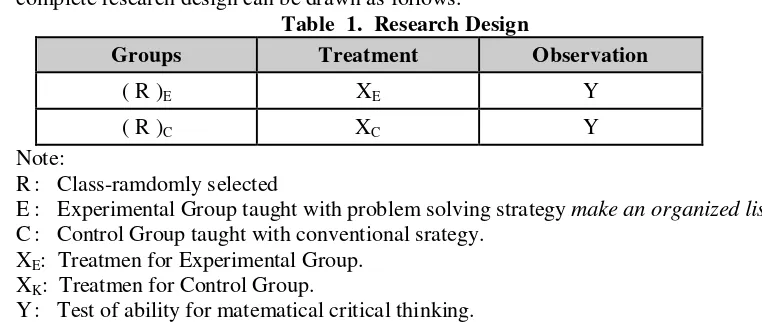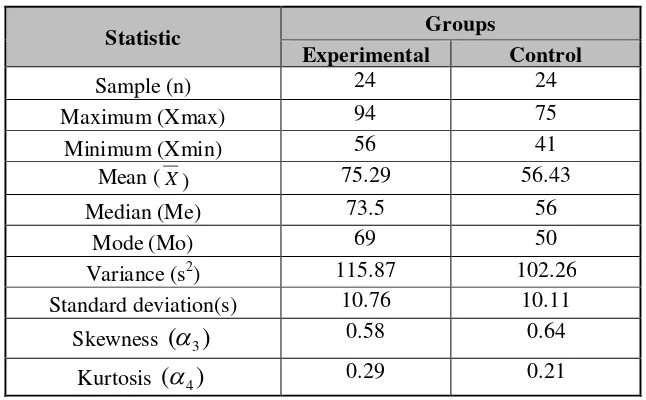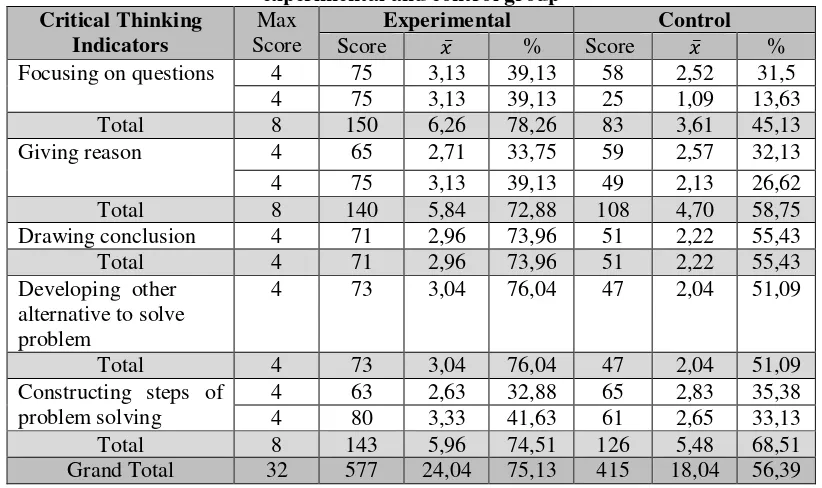M – 32
ENHANCING THE STUDENTS’ MATHEMATICAL CRITICAL THINKING
ABILITY THROUGH PROBLEM SOLVING STRATEGIES
MAKE AN
ORGANIZED LIST
Kadir 1, Latifah 2 and Eva Musyrifah 3
Department of Mathematics Education, UIN Syarif Hidayatullah Jakarta 1
[email protected], 2 [email protected], 3 [email protected]
Abstract
The purpose of this study is to analyze the effect of problem-solving strategies make an organized list on students’ ability of critical thinking in mathematics. This research was conducted at MTs in academic year 2014/2015. The method of the research used quasi-experimental method with control group post test only design. The Subject for this research were 47 students which selected through cluster random sampling technique. Data of the students’ mathematical critical thinking ability were collected thorough test. The results of this study show that students’ critical thinking ability who are taught using problem-solving strategies make an organized list is higher than who are taught using conventional strategies (thitung = 6.18 >ttabel = 2.01). It is seen from the indicators of mathematical critical thinking ability on aspects of the focusing on questions 78.26%, giving reasons 72.88%, drawing conclusion 73.96%, developing other alternative to solve problem 76.04% and aspects Constructing steps of problem solving 74.51%. Whereas, for students who are taught using conventional strategies on aspects of focusing on questions 45.13%, giving reason 58.75%, drawing conclusion 55.43%, developing other alternative to solve problem 51.09% and aspects Constructing steps of problem solving 68.51%. Thus, problem-solving strategies make an organized list significantly affect on students’ ability of critical thinking in mathematics.
Keywords: Problem-solving strategies, make an organized list, mathematical critical thinking.
INTRODUCTION A. Background
The growth of science and technology need much effort of the society to learn and use the way of thinking to choose and clarify information critically to compile decision making accurately to overcome any problems. One of the subjects which can develop the thinking ability is mathematics subject. This matter in line with characteristics of mathematics subject, that is to grow the way of thinking systematically, logically, creativelly, consistently and critically and also develop a positive attitude and self-confidence to solve problem.
Ability of mathematical critical thinking is included in High Order Thinking (HOT). This matter as according to The National Council of Teaching of Mathematic ( NCTM) in the year 1989 expressed that curriculum and evaluation were compiled as a standard in effort give a opportinity on student in each of the level of education to use the information critically. Thereby critical thinking as a high order thinking ability become one of the target which is programmed in order to develop curriculum internationally. However, the existing quaity of Indonesian mathematica eduction, especially in the aspect of ability critical thinking is still low.
the level of 64 from 65 nations with the score 375, and it was at the low level. Problem given in PISA divided to become 3 domain and 6 level, level 6 as the most complex problem storey; meanwhile, level 1 was the easiest. Level of the attainment in replying problem truly level 5 or level 6 coming near zero that is 0.3% and far from mean of other; the difference score of the students to other countries was at about reaching percentage 12.6%, but attainment at level 1 and level 2 very high about 75.7% compared to othe countries 23%. These data indicate that the Indonesian students can only interpret the situation in given problem, then finishing it through the common formula prosedure. Its meaning, Indonesian students only expand ability think low level having the character of prosedural and unable to develop on level of high order thinking, one of them is mathematical critical thinking (OECD, PISA 2012).
One of the learning strategy which are considered to improve ability of students’ mathematical critical thinking is problem solving strategy of make an organized list. Strategy of problem solving make an organized list is the learning strategy that can lead the students to list various alternative solution which most possible used as an alternative by the student. Through this strategy students can have a lot of opportunity to yield the ideas, able to open its sphere/opinion to solve problem, able to evaluate or consider a problem from various different point of view.
B. Formulation of the problem
To clarify and give proper direction in the formulation of the problem in this study, the researcher provides restrictions in accordance strategy used strategy of problem solving make an organized list. Critical thinking ability in mathematics limited at relation and function.
Based on the restrictions above, the researchers formulate the problems as follows: 1. How were the students’mathematical critical thinking of the students taught with
problem solving strategy make an organized list?
2. Was there any different ability of mathematical the students taught with problem solving strategy make an organized list and conventional strategy?
C. The objectives of the research
Based on the formulation of the problems, the study aims at:
1. Analyzing students’ mathematical critical ability of the students with problem solving strategy make an organized list.
2. Analyzing students mathematical critical ability between the students taught with problem solving strategy make an organized list and conventional strategy.
D. Significances of the Research
The results of the research are ecpected to give some significances not only theoretically but also pratically as follows:
1. For teachers, the results of the research could give both theoretically and pratically in improving their professionalism and as an alternative of mathematical learning model, especially in the mathematical critical thinking domain.
2. For students, problem solving strategiy make an organized list can be used as a learning model at home in order to enhance mathematical thinking and positive attitudes on mathematics.
3. For schools, this results can be useful for designing and evaluating the effectiveness of mathematical instructioan model to improve the mathematical thinking domain.
RESEARCH METHODOLOGY A. Method and Research Design
Research method used of this research was quasi-exsperiment. Meanwhile, research design applied for this research was Randomized Control Group Design. The complete research design can be drawn as follows.
Table 1. Research Design
Groups Treatment Observation
( R )E XE Y
( R )C XC Y
Note:
R : Class-ramdomly selected
E : Experimental Group taught with problem solving strategy make an organized list. C : Control Group taught with conventional srategy.
XE: Treatmen for Experimental Group. XK: Treatmen for Control Group.
Y : Test of ability for matematical critical thinking.
B. ResearchPopulation and Sample
Research population of this Research was those seventh grade students of MTs Daarul Hikmah Pamulang in academic year 2014/2015. While, the research sample was the seventh grade (VIII Iptek and VIII Imtaq) as the experimental and control class were 24 each. The choosing of the research sample used ClusterRandom Samplingtechnique.
C. Research Procedures
The treatment on both eksperimental and control class conducted with following some steps as follows: (1) to determine the instructional material, namely to identify the properties of function, relation, formula of function, table, graph, dan diagram, (2) to design lesson plan and students activity in exsperimental group with problem solving strategy on aspect
make an organized list and control group taught with conventional strategy, (3) to conduct instruction based on design has made., (4) to monitor the instruction 6 sessions, and (5) to conduct a test for measuring the level of the students matematical critical thinking on both groups.
D. Research Instruments
The instruments used in collecting data of the study consisted both test and non-test. The test instrument that used in this research was test mathematical critical thinking. Content validity the test conducted through expert judgment with using Content Validity Ratio (CVR) method from Lawshe (1975). Result of analysis CVR obtained 7 valid items with average of CVR about 0,81. Meanwhile, empirical item validity conducted through try out in the school, obtained 8 valid item with range (0.44 – 0.80) and reliability coefisient 0.76. Ability of students matematical critical thinking measured with holistic rubrics.
E. Data Analysis Techniques
Data analysis techniques used in this research covering both descriptive and inferensial technique. Descriptive technique used to gain information of tendency central and variabiliy data (mean, median, mode, range, standard deviation, variance, and skewness). Meanwhile, inferensial technique that used in this research was t-test with significance level
RESULTS AND DISCUSSION A. Research Results
The data ability of students matematical critical thinking both experimental and control group after treatment have conducted were drawn as follows.
Mathematical critical thinking ability
Result of descriptive analysis students’ ability mathematical critical thinking both problem solving make an organized list and convensional strategy group can be drawn as follows.
Table 1
Students’ mathematical critical thinking ability both experimental and control group
Statistic Groups
Standard deviation(s) 10.76 10.11
Skewness
(
3)
0.58 0.64Kurtosis
(
4)
0.29 0.21Base on analysis result at Table 1, show that 24 students both experimental and control group, obtained mean skor experimental group higher than control group with descrepancy about 18.86 (75.29 – 56.43) also median and mode at experimental group higher than control group. Thus, students’ mathematical critical thinking ability experimental group better than control group.
Visually data distribution both conduct instructional with problem solving strategy
make an organized list as follows.
Figure 1
1. Percentage ability base on indicators matematical critical thinking
Mathematical critical thinking ability this research covering: elementary clarification namely to focusing questions, basic support namely giving a reasoning, inference namely making conclusion and other alternatives to solve a problem, and strategies and tactics namely divising stages problem solving. Base on the mathematical critical thinking ability indicators, percentage both experimental and control group can be drawn as follows.
Table 2
Persentase ability of students base on indicators of mathematical critical thinking both experimental and control group
Base on analysis results in Table 2, shows that the biggest percentage on experimental group were focusing questions as much 78.26%, making other alternatives to solve a problem 76.04%. Meanwhile the smallest percentage on giving a reasoning 72.88% and making conclusion 73.96%. While at control group, biggest percentage in divising or constructing stages of problem solving finding a mistake mathematical statement indikator about 68.51%.
Visually data distribution both conduct instructional with problem solving strategy
make an organized list as graph follows.
Note:
A = Focusing questions B = Giving a reasoning C = Making conclusion
D = Making other alterna-tive to solve problem E = Constructing steps of problem solving
2. Normalitas and homogenity testing
Result of data normalitas and homogenity testing both experimental and control group can be drawn as follows.
Table 3
Normalitas testing result
Group n
2observ
2tabel Decision Experimental 24 0,05 0,14Normal distribution Control 24 0,05 0,13
While the data homogenty testing of mathematical critical thinking ability between example and control group can be drawn as follows.
Table 4
Homogenity testing result
Group n Variance (s2) Fobserv Ftabel Decision Experimental 24 115,87
1,13 2,04 Homogeneus variance Control 24 102,26
Base on analyis result as presented in table 3 and 4, the data of mathematical critical thinking ability both experiment and control group have normal and homogeneus variance distribution.
3. Hypothesis testing result
Difference analysis of mathematical mathematical critical thinking ability between the experimental and control group, conducted testing of hypothesis with t-test. Testing result can be drawn as follows.
Table 4 t-test resul
tobserv ttabel Decision
6,18 2,01 Reject H0
Base on analysis result on table 4 show that tobserv > ttabel (6,18 2,01) hence can be concluded to reject H0. Therefore, mean skor mathematical critical thinking students taught with problem solving strategy make an organized list higher than conventional strategy.
B. Discussion
In general, the research findings indicate that the average of students’ mathematical critical thinking of experimental group is higher than control group with the difference 18,86 (75,29 – 56,43). This finding shows the similarity with Yanto Permana and Utari Sumarmo (2007) revealed that students’ mathematical reasoning ability of Students acquire problem-based learning is better than students mathematical reasoning through the conventional instruction.
organized list was 78,26%, and develop other alternatives to solve a problem = 76,04% and
conventional strategy as much 45,13% and 51,09%. Meanwhile the smallest percentage on giving reason 72,88% and drawing conclusion 73,96%. While at control group, biggest percentage in divising or constructing stages of problem solving finding a mistake mathematical statement indikator about 68,51%. So, it can be said that the indicators focusing on questions that students who were taught by problem solving strategies make an organized list was higher than they were taught by conventional strategy. Description indicators focusing on questions students are taught by problem-solving strategy make an organized list shown can answered completely and precisely.
Meanwhile for the group that was taught through conventional strategy is less complete, not complete to determine of focusing on questions. In general, ability of mathematical critical thinking each indicators who are taught by problem solving strategy make an organized list,
higher then conventional strategy. These findings are similar to findings of Fahinu (2007: 18) who reported that the use of a counter-example to effectively improve critical thinking skills of students of mathematics and students can broaden their horizons about the statement is true and false as well as being a strategy of evidence to prove the statement calculus
The next finding about ability of mathematical critical thinking who were taught by problem-solving strategy make an organized list is higher than students are taught through by conventional strategy shows that student used to understand the problem, divising a plan, carry out the procedure to solve the problem and finally the students drawing conlusion. Differ from the group that are taught through conventional strategy, the students understand of what the teachers has been taught, find the matter with different problem, using inappropriate procedure to solve the problem. These findings are supported by the students activities who are taught by conventional strategy where the teachers’ role more dominate in giving description about function, relation, and formula the students detailly, so the students used to follow the steps to find the true statement from the teacher. Meanwhile the exprimental group, where the instructional process focus on students when they have a role in a group.
Based on the above findings, in general, mathematical critical thinking ability of students who are taught by the problem solving strategy make an organized list on the subject of function and relation, which is applied to the learning process in this study has a positive impact on students’ ability of critical thinking in mathematics.
CONCLUSION AND SUGGESTIONS A. Conclusion
Based on the research results and disussion, it can be concluded that:
The ability of mathematical critical thinking based on its’ indicator for the students were taught by problem solving strategy make an organized list is higher than the students who are taught by conventional strategy. This case can be seen from the indicator of mathematical critical thinking students who were taught by problem solving strategy make an organized list aspects of the focusing on questions is about 78.26%, giving reason is about 72.88%, drawing conclusion 73.96%, develop another alternative to solve problems about 76.04% and stages in solving problem is about 74.51%. Whereas, for students who are taught using conventional strategy on focusing on questions is about 45.13%, giving reasons is about 58.75%, drawing conclusion is about 55.43%, develop another alternative to solve problems is about 51.09% and stages in solving problem is about 68.51%. Thus, problem-solving strategies make an organized list significantly affect on students’ ability of critical thinking in mathematics.
B. Suggestions
Based on research conclusions, it can be delivered some suggestions as follows: 1. Based on the research results that learning mathematics with problem solving make an
organized list can enhance the ability of mathematical critical thinking , so that it can be an alternative for students’ learning mathematics at home.
2. To improve the ability of mathematical reasoning critical thinking. Therefore, students need to be trained and socialized to learn to solve problems during the learning process with a variety of problem solving strategies.
3. Student activity sheets and instruments used in this study can be used to further improvements to measure the development of the students’ mathematical thinking.
4. For completing finding of this results, It needs to be conducted further investigation to what extent does the effect of each problem-solving strategy make an organized list on other aspects of mathematical thinking abilities.
REFERENCES
Fahinu. (2007). Efektifitas Penggunaan Metode Bukti Counter-Example Dalam Meningkatkan Kemampuan Berpikir Kritis Mahasiswa Matematika. Jurnal WAKAPENDIK Vol. 3 No. 2.
Lawshe, CH. (1975) A quantitative approach to content validity. By Personnel Psychology, INC.
National Council of Teacher of Mathematics, Curruculum and Evalution Standarts for School Mathematics.Reston Virginia: NCTM, 1989.
OECD. “PISA 2012 Results In Focus”, http://www.oecd.org/pisa/keyfindings/pisa-2012-results-overview.pdf, 2013.



